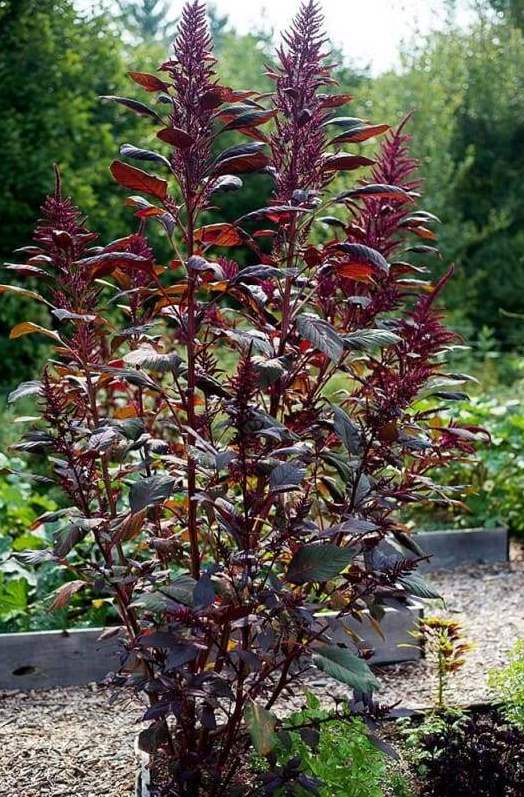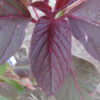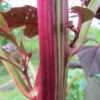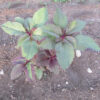Description
Red Garnet Amaranth (A.K.A. Joseph’s Coat [U.S.], Kiwicha [Andes Region], Chinese Spinach [Asia], Yin Choi [China])
100 Seeds per pack
Annual Herb
Days to Maturity: 40-120 Days
Botanical Name: (Amaranthus hypochondriacus)
Red Garnet Amaranth remains a staple food in modern Mexico and parts of Asia, celebrated for its versatility, nutritional value, and striking appearance. Cultivated for centuries, this variety has gained worldwide acclaim for its adaptability and multifunctional uses in both the kitchen and garden. In Mexico, its nutrient-rich grains are used to make “alegría,” a traditional sweet treat, usually sweetened with honey or molasses. Amaranth seeds are high in protein, fiber, and various minerals, making flour from ground amaranth seeds a nutritious addition to the diet. Amaranth Flour is an excellent gluten-free option. The grain also becomes a complete protein when combined with another grain. A regular powerhouse in the kitchen!
Red Garnet Amaranth offers tender, oval-shaped leaves that are green with striking burgundy-red overlays radiating from the central vein. These young leaves, ready for harvest as early as 40 days, add vibrant color and a delicate flavor to salads or can be cooked like spinach. When left to mature, the plant reaches heights of 6–10 feet, crowned with stunning upright flower spikes in rich shades of red and fuchsia. The vivid leaf and flower colors develop best in high heat, making this variety a stunning addition to warm-climate gardens. The pale cream-colored grains can be toasted and eaten, ground into a gluten-free flour, or cooked as a nutritious alternative to traditional grains.
A tropical plant by nature, Red Garnet Amaranth thrives in warm soil and performs best in temperatures ranging from 60°F to 95°F. It is highly drought tolerant, heat loving, and requires ample space to reach its full potential. This annual is well-suited for long summer growing seasons, where its bold hues intensify under high heat and its robust growth habit shines. It can also be harvested as microgreens within 15 days, making it a fast-growing option for culinary use.
In addition to its beauty and culinary versatility, Red Garnet Amaranth is rich in nutrients. In vitamin content, the greens boast higher iron content than nearly any other vegetable, second only to parsley, and provide vitamins C, E, and K, along with beta-carotene and calcium. The greens are similar to spinach, with a slightly nutty flavor, and are best when young as they can become slightly astringent when mature; young leaves are mild and can be added to salads, while older leaves are better cooked like spinach. The grains are loved for their sweet, nutty, and mildly earthy flavor. The leaves can even be used to produce a natural red dye, further highlighting its multifunctional value.
Whether grown for greens, grains, or as a stunning garden focal point, Red Garnet Amaranth is a beautiful, easy-to-grow variety that stands out in any edible flower or vegetable garden.
Planting Instructions for Amaranth – Red Garnet Seeds
When to Plant:
Start Red Garnet Amaranth seeds indoors 6 to 8 weeks before your last expected spring frost. If sowing directly outdoors, wait until after all danger of frost has passed and the soil has warmed to at least 70°F. Amaranth thrives in heat and will not tolerate cold soil.
How to Start Indoors:
Fill seed trays or pots with moist, well-draining seed-starting mix. Sow 2 to 3 seeds per cell, pressing them gently onto the soil surface—do not cover them, as amaranth seeds require light to germinate. Maintain a consistent soil temperature between 70 and 80°F. Keep the surface moist until germination, which takes 10 to 15 days. Once seedlings emerge, thin to the strongest one per pot. After hardening off, transplant outdoors once the weather is reliably warm. Space plants according to your growing goals: 6–12 inches apart for baby greens or ornamental foliage, or 18–24 inches apart for full-sized plants grown for seed and height, which may reach up to 10 feet.
How to Sow Outdoors:
Prepare a sunny, well-drained garden bed, enriching the soil with compost or well-rotted manure. Sow seeds directly on the surface, pressing them in lightly without covering. Space groups of seeds every 3 to 6 inches. Once seedlings are established, thin them according to your growing goals: 6–12 inches apart for baby greens or ornamental foliage, or 18–24 inches apart for full-sized plants intended to reach 6–10 feet tall and produce large seed heads.
Growing:
Amaranth grows best in full sun and fertile, loose soil that drains well. Water regularly, allowing the top inch of soil to dry between waterings—once or twice a week is usually sufficient in dry weather. Mulch can help retain moisture and suppress weeds. Pinch back young plants to encourage bushier growth and tender leaf production. For tall plants, ensure ample spacing and strong soil fertility to support vigorous vertical growth.
Harvesting and Seed Saving:
Begin harvesting leaves when plants are around 12 inches tall. Younger leaves are more tender and ideal for fresh use, while older leaves are better suited to cooking. For seed production, allow flower heads to mature and dry on the plant. When seed heads turn brown and begin to shatter, cut the stalks and hang them upside down over a paper bag to finish drying. When they have thoroughly dried, shake out the seeds and store them in a cool, dry place. We also offer Seed Saving Envelopes to make organizing and storing your harvest simple and tidy!
FAQ
What is the historical or notable background of Red Garnet Amaranth?
Red Garnet Amaranth has been cultivated for centuries and remains a staple food in modern Mexico and parts of Asia. It is known for its adaptability, multifunctional uses, and rich nutritional value. In Mexico, its nutrient-rich grains are used to make “alegría,” a traditional sweet treat.
How would you describe the flavor profile of Red Garnet Amaranth?
The greens have a slightly nutty flavor, similar to spinach, with young leaves being mild and tender, while mature leaves develop a slight astringency. The grains are sweet, nutty, and mildly earthy, making them a versatile ingredient in both sweet and savory dishes.
What does Red Garnet Amaranth look like?
This variety features tender, oval-shaped green leaves with striking burgundy-red overlays. It can grow up to 6–10 feet tall, producing stunning upright flower spikes in rich red and fuchsia hues. Its pale cream-colored grains are small but packed with nutrition.
What are the growth habits and garden appeal of Red Garnet Amaranth?
Red Garnet Amaranth is a fast-growing, heat-loving annual that thrives in warm climates. It can be harvested as microgreens within 15 days or allowed to mature into a tall, ornamental plant. Its vibrant foliage and dramatic flower spikes make it a striking addition to gardens.
What climate conditions are ideal for growing Red Garnet Amaranth?
This tropical plant flourishes in warm soil with temperatures between 60°F and 95°F. It is highly drought-tolerant, loves heat, and grows best in long summer seasons where high temperatures enhance its vivid colors.
What are the common culinary uses for Red Garnet Amaranth?
The young leaves can be eaten raw in salads or cooked like spinach, while mature leaves are better suited for steaming or sautéing. The grains can be toasted, ground into gluten-free flour, or cooked as a nutritious alternative to traditional grains.
How should Red Garnet Amaranth be stored and practically used?
Harvested leaves should be stored in the refrigerator and used within a week for the best flavor and texture. The grains can be dried and stored in an airtight container in a cool, dry place. Flour made from amaranth grains should be kept in an airtight container to maintain freshness.
What vitamins or nutrients does Red Garnet Amaranth contain?
Red Garnet Amaranth is rich in iron—higher than most vegetables except parsley—and provides vitamins C, E, and K, along with beta-carotene and calcium. The grains are high in protein, fiber, and essential minerals, making them a great addition to a healthy diet.
Does Red Garnet Amaranth have any notable disease resistance?
This variety is highly resilient, thriving in warm, dry conditions with excellent drought tolerance. It is not particularly prone to common plant diseases but may attract leaf miners or flea beetles in certain conditions. Proper spacing and air circulation can help prevent pest issues.






















Laura D. (verified owner) –